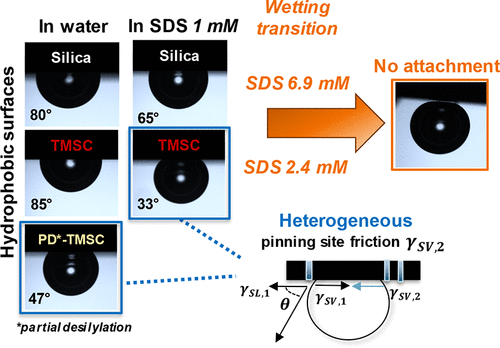Our official English website, www.x-mol.net, welcomes your
feedback! (Note: you will need to create a separate account there.)
Bubble Attachment to Cellulose and Silica Surfaces of Varied Surface Energies: Wetting Transition and Implications in Foam Forming.
Langmuir ( IF 3.7 ) Pub Date : 2020-06-08 , DOI: 10.1021/acs.langmuir.0c00682 Annika E Ketola 1 , Wenchao Xiang 2 , Tuomo Hjelt 1 , Heikki Pajari 1 , Tekla Tammelin 1 , Orlando J Rojas 2, 3 , Jukka A Ketoja 1
Langmuir ( IF 3.7 ) Pub Date : 2020-06-08 , DOI: 10.1021/acs.langmuir.0c00682 Annika E Ketola 1 , Wenchao Xiang 2 , Tuomo Hjelt 1 , Heikki Pajari 1 , Tekla Tammelin 1 , Orlando J Rojas 2, 3 , Jukka A Ketoja 1
Affiliation

|
To better understand the complex system of wet foams in the presence of cellulosic fibers, we investigate bubble–surface interactions by following the effects of surface hydrophobicity and surface tension on the contact angle of captive bubbles. Bubbles are brought into contact with model silica and cellulose surfaces immersed in solutions of a foaming surfactant (sodium dodecyl sulfate) of different concentrations. It is observed that bubble attachment is controlled by surface wetting, but a significant scatter in the behavior occurs near the transition from partial to complete wetting. For chemically homogeneous silica surfaces, this transition during bubble attachment is described by the balance between the energy changes of the immersed surface and the frictional surface tension of the moving three-phase contact line. The situation is more complex with chemically heterogeneous, hydrophobic trimethylsilyl cellulose (TMSC). TMSC regeneration, which yields hydrophilic cellulose, causes a dramatic drop in the bubble contact angle. Moreover, a high interfacial tension is required to overcome the friction caused by microscopic (hydrophilic) pinning sites of the three-phase contact line during bubble attachment. A simple theoretical framework is introduced to explain our experimental observations.
中文翻译:

各种表面能的气泡附着在纤维素和二氧化硅表面上:润湿转变和泡沫形成的意义。
为了更好地理解纤维素纤维存在下湿泡沫的复杂系统,我们通过跟踪表面疏水性和表面张力对俘获气泡接触角的影响来研究气泡-表面相互作用。使气泡与浸泡在不同浓度的起泡表面活性剂(十二烷基硫酸钠)溶液中的模型二氧化硅和纤维素表面接触。观察到气泡附着是由表面润湿控制的,但是在从部分润湿到完全润湿的过渡附近,行为发生了明显的分散。对于化学均匀的二氧化硅表面,在气泡附着过程中的这种过渡通过浸没表面的能量变化与移动的三相接触线的摩擦表面张力之间的平衡来描述。对于化学上不均一的疏水性三甲基硅烷基纤维素(TMSC),情况更为复杂。TMSC再生产生亲水性纤维素,导致气泡接触角急剧下降。而且,需要高的界面张力来克服在气泡附接期间由三相接触线的微观(亲水)钉扎部位引起的摩擦。介绍了一个简单的理论框架来解释我们的实验观察。
更新日期:2020-07-07
中文翻译:

各种表面能的气泡附着在纤维素和二氧化硅表面上:润湿转变和泡沫形成的意义。
为了更好地理解纤维素纤维存在下湿泡沫的复杂系统,我们通过跟踪表面疏水性和表面张力对俘获气泡接触角的影响来研究气泡-表面相互作用。使气泡与浸泡在不同浓度的起泡表面活性剂(十二烷基硫酸钠)溶液中的模型二氧化硅和纤维素表面接触。观察到气泡附着是由表面润湿控制的,但是在从部分润湿到完全润湿的过渡附近,行为发生了明显的分散。对于化学均匀的二氧化硅表面,在气泡附着过程中的这种过渡通过浸没表面的能量变化与移动的三相接触线的摩擦表面张力之间的平衡来描述。对于化学上不均一的疏水性三甲基硅烷基纤维素(TMSC),情况更为复杂。TMSC再生产生亲水性纤维素,导致气泡接触角急剧下降。而且,需要高的界面张力来克服在气泡附接期间由三相接触线的微观(亲水)钉扎部位引起的摩擦。介绍了一个简单的理论框架来解释我们的实验观察。











































 京公网安备 11010802027423号
京公网安备 11010802027423号